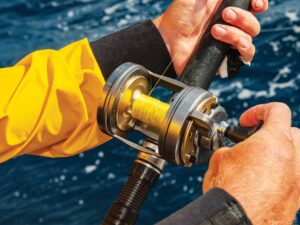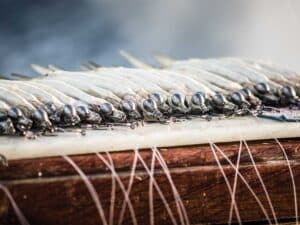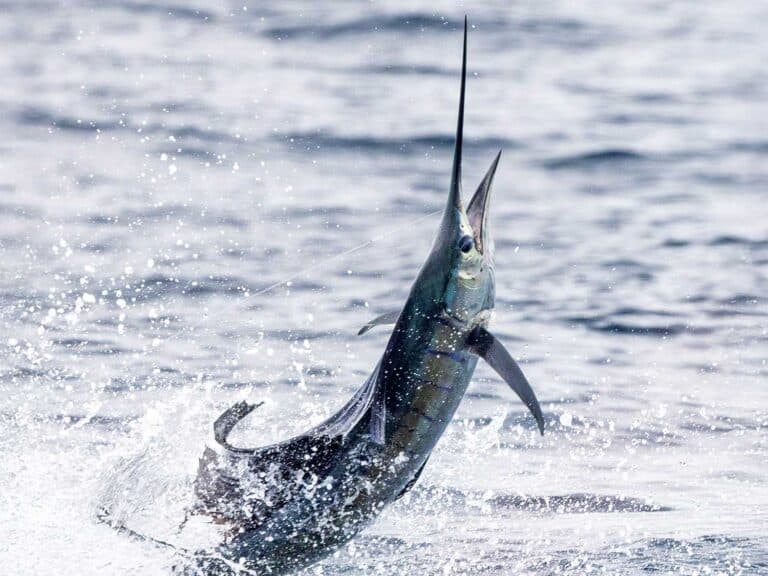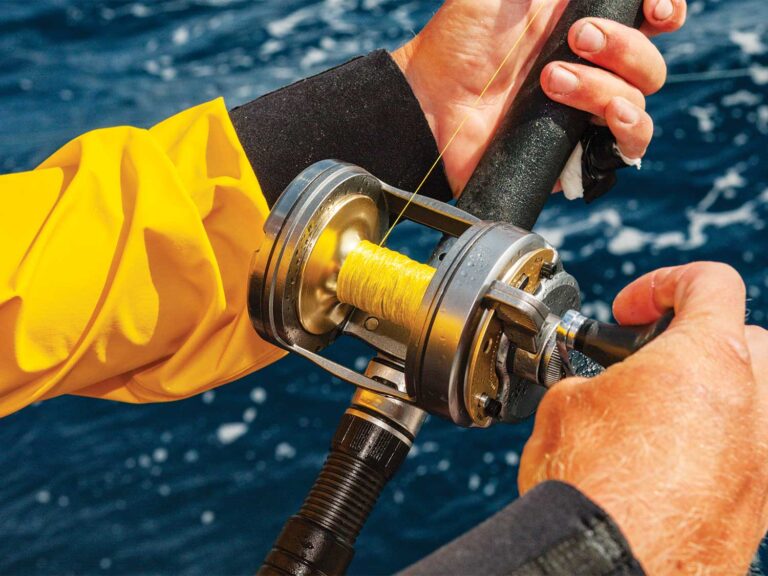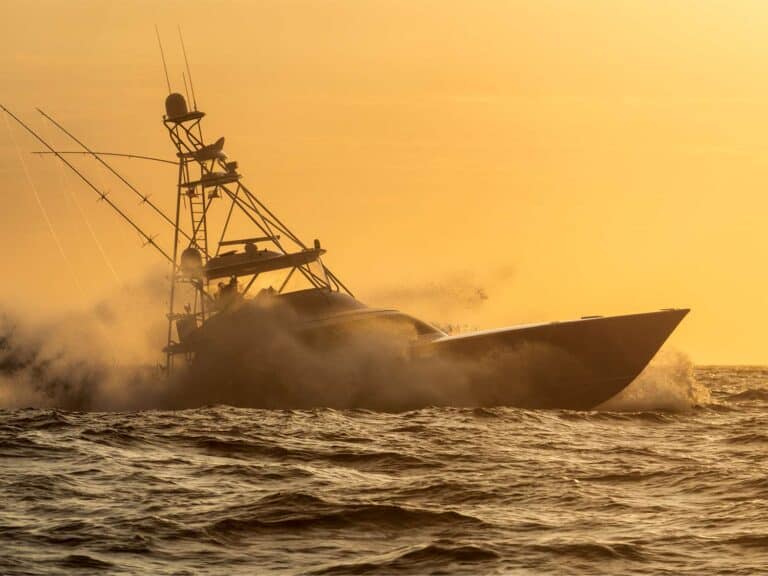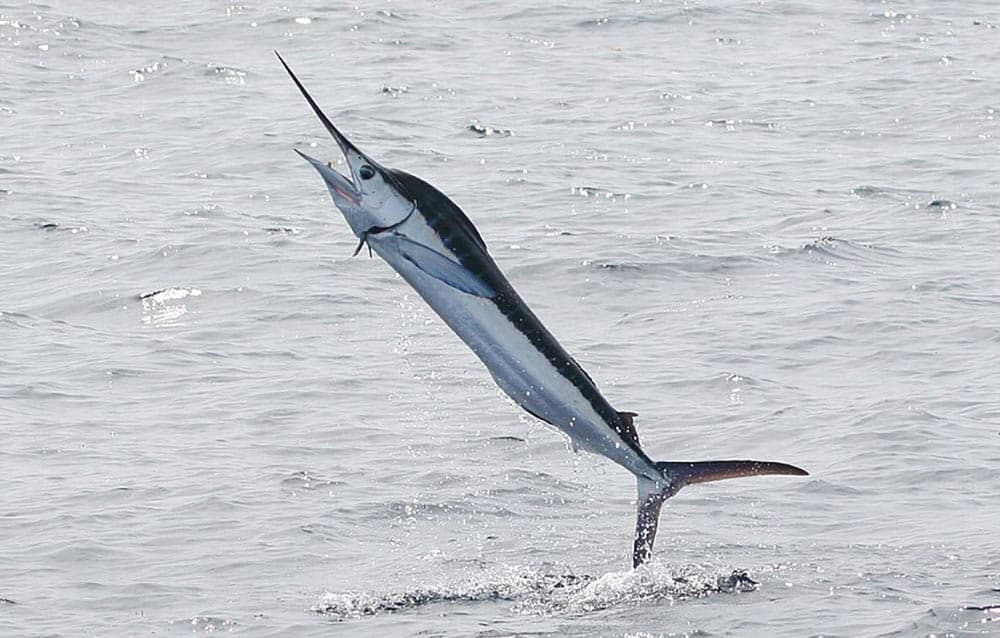
White marlin live in the epipelagic zone — between the latitudes of 45 degrees north and 45 degrees south — of the tropical and subtropical Atlantic Ocean, Gulf of Mexico and the Caribbean Sea, preferring water temperatures in the mid-70s. Sometimes refered to as a skilligalee, but more widely-known simply as “whitey,” they can be recognized by the rounded pectoral, anal, and usually the dorsal fins. Smaller than most billfish and displaying a more greenish hue than other marlin, their average weight is 60 pounds at adulthood, and all white marlin display black spots on their dorsal fins.
Thought to be on the decline since 1990, several studies, requirements and gear restrictions have been implemented to help return the highly migratory species stock to a healthy level. With the invent of circle hooks for billfish in 2000, brought on by a grant from The Billfish Foundation to fund the tackle company, Eagle Claw to research and develop a light-wire circle hook that could be used by recreational billfish anglers, the numbers of catches and releases — both recreationally and commercially — have sky-rocketed.
It is estimated that United States anglers catch over 10,000 white marlin annually, although it is thought more than 25 percent of these fish are actually roundscale spearfish. Conservation of the species has awarded the recreational fishing community with near-record releases as of late, and as the trend continues, it is anticipated the numbers will continue to grow.
White Marlin Quick Facts
Known for their cautious nature, sneakiness and acrobatics once hooked, anglers who master the art of white marlin fishing are rewarded with a show and can post up significant numbers once a biomass is located.
- Scientific name: Kajikia albidus
- Main food source: Squid and other small pelagic bait fish
- All-tackle World Record: 181 pounds caught in Brazil, 1979
- The pectoral fins light up an electric blue when excited and can fold along the body at will.
- The fish’s coloration is marked by colors of dark blue to green above the lateral line, fading to a silvery-white below.
- Commercial longliners provide the best information to scientists to better understand the species’ movements and migratory patterns.
- Tag-and-recapture data suggests a single stock of white marlin inhabit the Atlantic, with pop-up data tags providing movements of the species both horizontally in migratory patterns and vertically movement within the water column while searching for food.
- The main driver of white marlin migration is tracked to water temperature.
- Scientists believe white marlin spawn in the Western Central Atlantic April to June.
- The average life span of a white marlin is 18 years.
White Marlin Fishing Tips
Fishing for release numbers when targeting white marlin is best done while dead-bait trolling. In a kill tournament situation, where you are looking for the biggest fish, most fisherman will opt to pull lures since usually only the largest of the species will stay connected.
While dead-baiting, the simple spread is always best: four chin-weighted, unskirted — or naked — ballyhoo rigged with floss, copper wire and an O-ring or swivel connection for circle hooks; two in the long rigger and two in the flatline position, clipped to the covering board; two squid chain teasers (hookless) on either side with large ballyhoo chase baits controlled by the helmsman; and two dredges with either ballyhoo, mullet or a combination of natural and artificial offerings controlled by the cockpit personnel.
In areas where live-baiting is acceptable and kite-fishing is popular, it is important to match the hatch: Goggle-eyes, sardines, herrings, and even ballyhoo are an acceptable kite bait for targeting white marlin.
Because these marlin are extremely sneaky, and each one of them will eat a different way, you can expect to miss a few, or more. Depending on the amount of fish seen in the area, rigging up to 100 baits per day is not out of the norm. Being prepared is always better than being in the weeds, so pre-making your hook leaders will keep you in the game, with little down time.
You should always stand at the ready when white marlin fishing because you must beat the fish to the rigger. If he pops it out of the clip before you see him (or he sneak-attacks you and you have no warning), hold the reel with your thumb in freespool until he takes it from you. Just because the fish hit the bait doesn’t mean he ate it. If you immediately let the line out when it comes out of the rigger, the bait will soar over the fish’s head and he usually won’t follow it. Once you lose sight, or never saw him, steadily wind the bait back into its original position in the spread. Hold the rod high enough so the bait acts as much like it did before he took the shot. If you see there is only a head, reel it in and quickly replace it.
It is not uncommon for a white marlin to wheel around after you miss and take another try.
If you see that your bait is still good, put it back in the clip until you are sure he is gone and then switch it out for a new one. These fish are picky and having a non-par bait will keep you from getting bit.
When you get a bite on the flat line, or it pops out of the clip, hold the reel out of gear low to side and let the fish pull on you before you feed it to him. The flat line bait usually swims below the surface, so keeping your bait down and swimming is key, so lower your rod tip to the side
If you see a fish come up on the flat line, teaser or dredge before he takes a shot, get the line out of the clip and do what the captain instructs you to do. Remember, no matter how well you can spot fish, he has the better vantage point, so listening to him will keep your odds higher for a hook-up.
White Marlin Fishing Destinations
Since white marlin migrate with the water temperature — in search of that 75-degree water they like so well — there will be several locations at different times of the year to target them. Large numbers of white marlin can be found in areas of the Bahamas and the Florida coastline, where temperatures are steered by the Gulf Stream in the winter and early spring.
White marlin can also be found in the eastern Bahamas — away from the Gulf Stream — in the springtime. As the water gets too warm, the fish will slowly migrate north, ending up in the Northeast Canyons by late-summer and early-fall before making another push south toward the Carolinas as the water cools down.
The body of fish that frequent the Yucatan in the spring and early summer will migrate toward the Gulf of Mexico to spawn in the early summer. Some of those fish will meander around while others will break off and head toward the Gulf Stream. The meanderers usually find themselves back in Mexico, while the ones that split from this group go either to the Bahamas or head up the U.S. coast but these migratory patterns are still being studied.
White marlin can also be found in the Caribbean, depending on the time of year.
